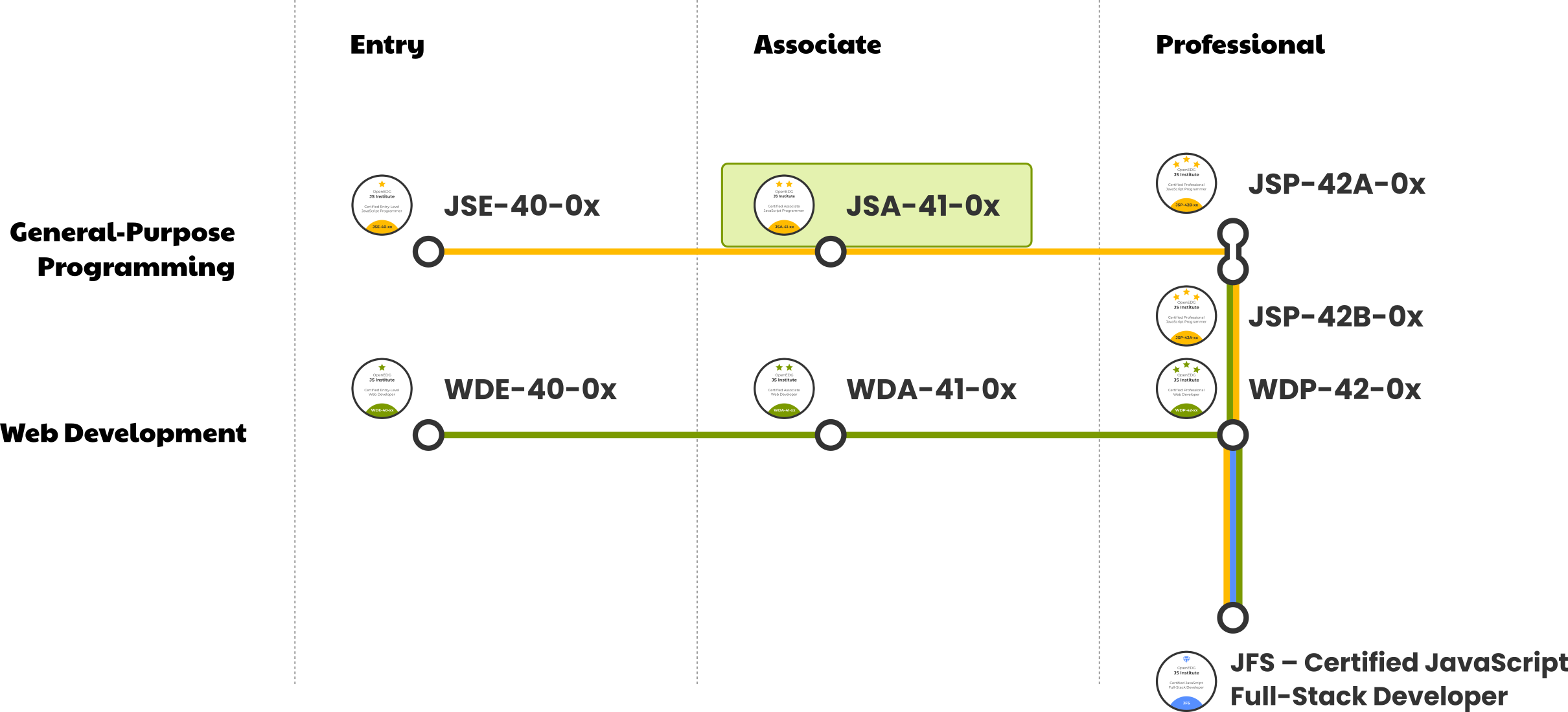- About
- Certifications
- Study Resources
-
Study Resources
- JavaScript Essentials 1
- JavaScript Essentials 2
- HTML Essentials
- CSS Essentials
General-Purpose Programming
Web Development
- Contact
- Voucher Store
JSA™ – Certified Associate JavaScript Programmer certification is a professional credential that demonstrates the candidate’s proficiency in Object-Oriented Analysis, Design and Programming (OOA/OOD/OOP), as well as the more advanced use of functions in the JavaScript language.

The certification holder understands the Object-Oriented Programming approach to JavaScript (objects: literals, properties, dot and bracket notation, property existence tests, property enumeration; object features: references; methods, property/object configuration, prototypes; classes: design, declarations, properties, getters, setters, inheritance, static members, constructors), is skilled in the advanced use of built-in objects, including simple data types and their constructors, composite data types, and some of the most useful objects (JSON, Math, RegExp, extending built-in types), is proficient in using the mechanism of advanced functions in JavaScript, such as recursion, forwarding calls, decorators, functional programming, generators, iterators, and asynchronous programming, including callback functions and promises.
Moreover, the certified individual knows how to adopt the best programming practices, techniques, and conventions in JavaScript programs; thinks algorithmically, analyzes and models problems using an objective conceptual apparatus; understands the role and work of a programmer in the software development process, and knows how to use the most fundamental development tools.
JSA certified ensures that the individual is acquainted with the essential means provided by the JavaScript language to enable them to design, develop, deploy, refactor, and maintain JavaScript programs and applications; analyze and model real-life problems in Object-Oriented Programming categories; create and develop their own programming portfolio; and start their own studies at a professional level, and to continue their further professional development.

The JSA – Certified Associate JavaScript Programmer certification exam covers the following topic areas and measures the following skills:
Object.create();in, for...in (own-filtered), and Object.keys/values/entries;Object.assign(), spread, and deep-clone strategies;this context correctly in method calls;Object.defineProperty, preventExtensions, seal, freeze);[[Prototype]]/__proto__, work with Function.prototype, and set prototypes with Object.setPrototypeOf;new and verify relationships using instanceof;extends, override members, and call parent logic via super;static properties and methods on the class itself;Number for conversions and formatting; apply key static properties and methods;String APIs;Date, handle UTC vs. local time, measure elapsed time;find, every, some, filter, sort, map, reduce;Set for unique collections: construct, add/has/delete/clear/size, iterate, and spread;Map for key–value collections: construct, set/get/has/delete/clear/size, and iterate;JSON.stringify and JSON.parse;Math (rounding, random, min/max, abs, pow, log, trig);RegExp and string methods (test, exec, match, search, replace);call, apply, and bind;then, catch, and finally;Promise.all, Promise.any, and Promise.race;async functions and manage control flow with await and try/catch;XMLHttpRequest and the Fetch API;The holder of the JSA™ – Certified Associate JavaScript Programmer certification demonstrates the following skills and expertise: